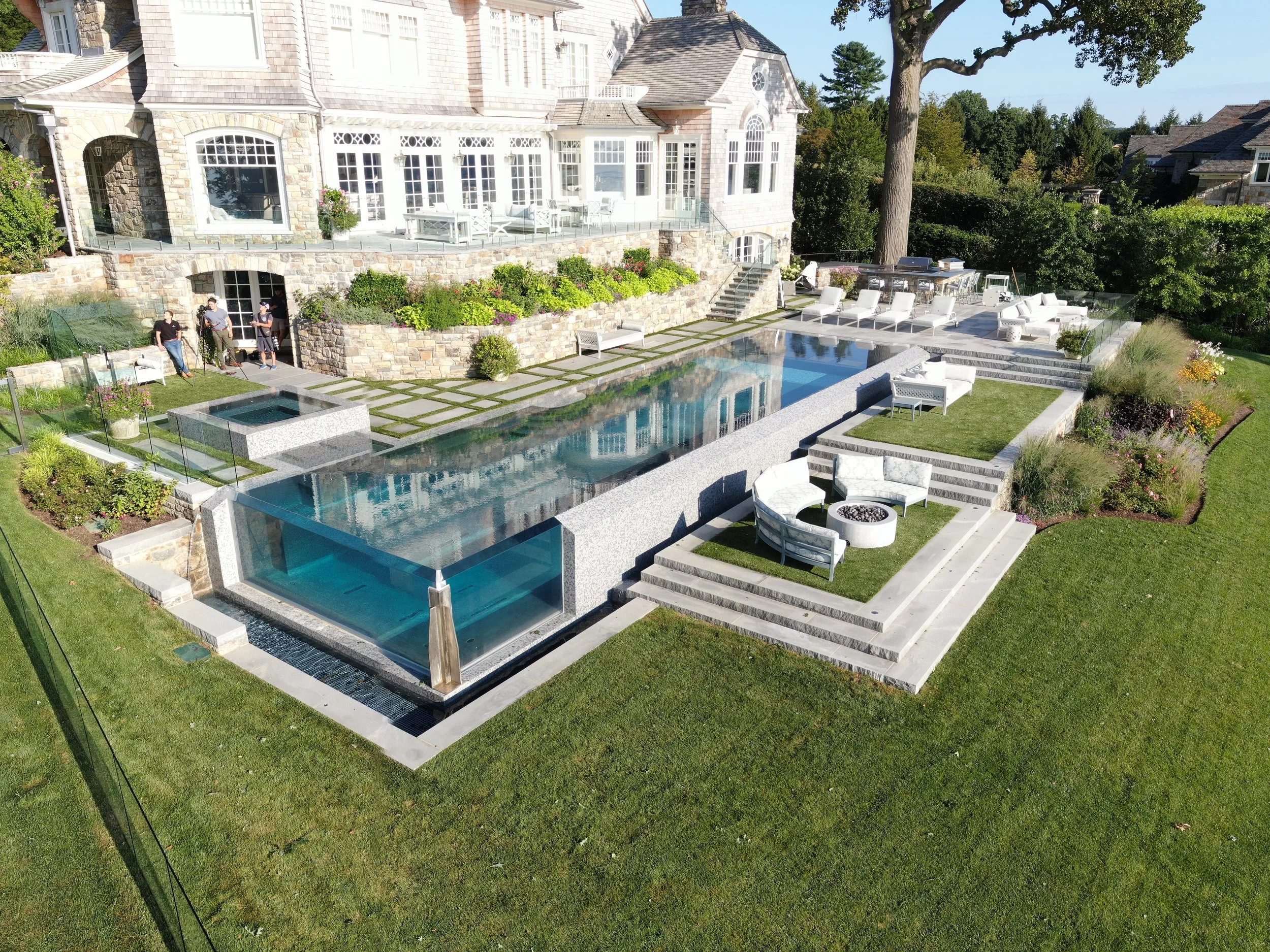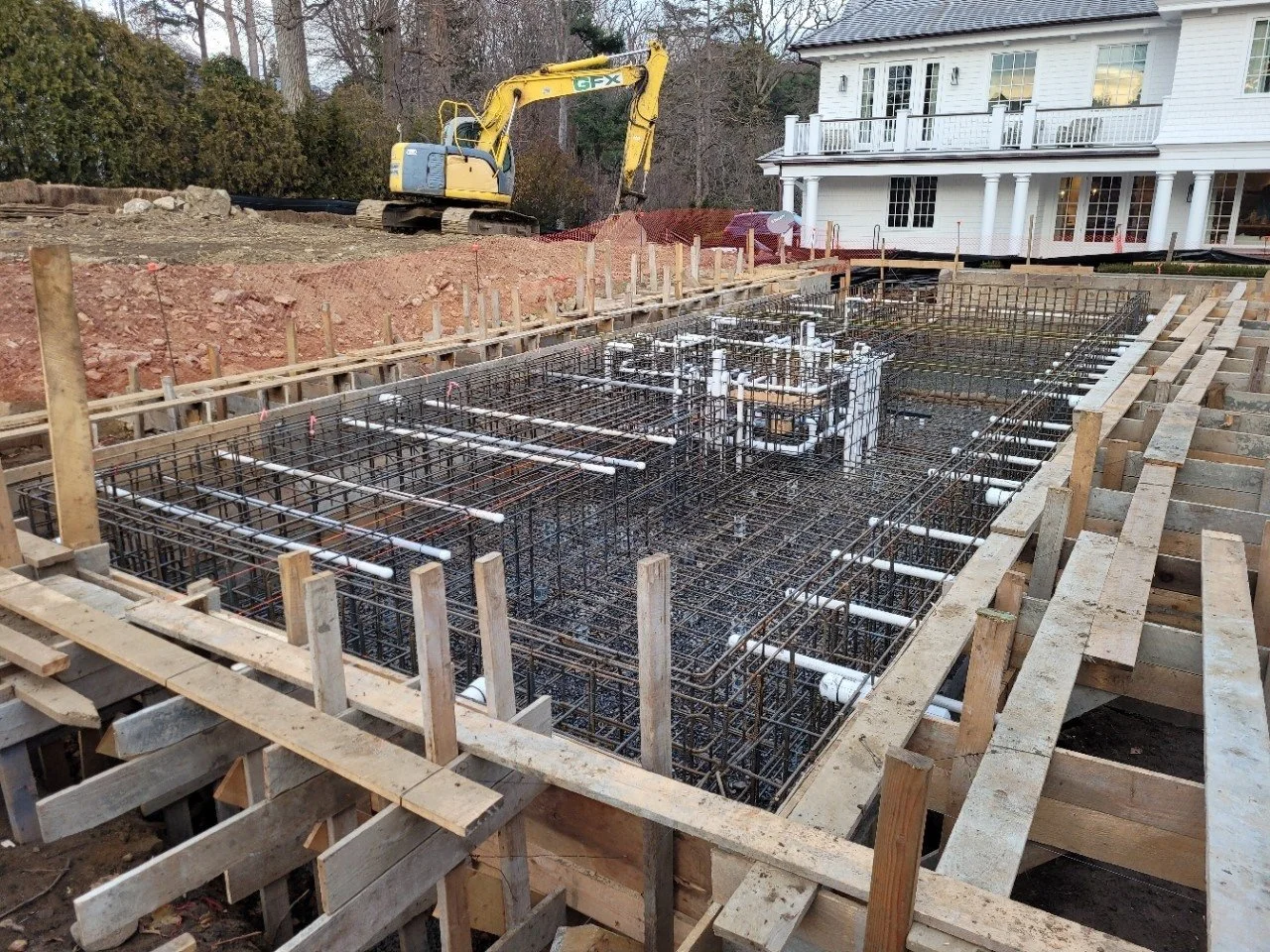The swimming pool design and construction industry is not highly regulated, and in some cases, it is simply not regulated. Some states and municipalities require licensed professional engineers to design all pools. Some jurisdictions require only commercial pools to have a set of plans and specifications that are produced and sealed by a licensed design engineer. Unfortunately, they have no requirements for a licensed engineer to design a residential pool.
Residential pools can far exceed $100,000 in cost depending on the complexity. They have pumping and piping systems, drains, sumps filters, electrical, and water treatment equipment. Today’s pools are no longer just rectangular concrete swimming ponds in the backyard (Fig. 1).
Fig. 1: Partially buried, embedded window, infinity edge residential pool. Not just a basic backyard swimming hole (Photo courtesy of Drakeley Pools).
Thus, though the industry is large, the pool designers have free rein to do whatever. Many are not licensed professional engineers and have no requirements to seal a set of drawings or specifications. Some designers sell typical pool designs that take no account of the local site conditions or environmental exposures. The pool industry is totally unregulated in many states. Where some states do require designs which are signed and sealed, they still rely on the engineer’s various degrees of experience or selection preferences from existing codes that do not directly relate to pool design and construction. This isn't necessarily the fault of the designer as there is not a well-established industry standard to set minimum requirements in the pool industry.
ASA has established a set of position statements for the pool industry. They address issues including Compressive Strength Values of Pool Shotcrete, Shotcrete Terminology, Sustainability of Shotcrete in the Pool Industry, Watertight Shotcrete for Swimming Pools, Monolithic Shotcrete for Swimming Pools (No Cold Joints), Forming and Substrates in Pool Shotcrete, and Curing of Shotcrete for Swimming Pools.
The ASA position statements are valuable to convey the expectations of good practices in the pool marketplace. Perhaps they will even start to set an industry standard. But these are short, non-mandatory documents meant to provide guidance. ASA is not a standards-developing organization (SDO) like ACI or ASTM.
A code is a mandatory language document that provides minimum requirements for design and some construction aspects of the structure within its scope. For example, when engineers design buildings, it is clear they use ACI 318 Building Code Requirements for Structural Concrete and Commentary. Proper use of ACI 318 is taught throughout their college education and widely used in the industry in many parts of the world.
So, where are we in the pool industry? The current International Swimming Pool and Spa Code (ISPS) has a minimal basis for concrete pool design. Here are the current ISPSC provisions for structural design:
802.1 Materials of components and accessories.
“The materials of components and accessories used for permanent inground residential swimming pools shall be suitable for the environment in which they are installed. The materials shall be capable of fulfilling the design, installation, and the intended use requirements in the International Residential Code."
802.2 Structural design.
“The structural design and materials shall be in accordance with the International Residential Code."
SECTION 803
CONSTRUCTION TOLERANCES
803.1 Construction tolerances.
"The construction tolerance for dimensions for the overall length, width, and depth of the pool shall be + 3 inches (76 mm). The construction tolerance for all other dimensions shall be + 2 inches (51 mm), unless otherwise specified by the design engineer."
These three short sections don't even fill a full page. That's it for the ISPSC on concrete pool structural design. The requirement is to just use the International Residential Code (IRC) for structural design.
Let's turn to the Introduction of the International Residen-tial Code (IRC) where we find:
"The International Residential Code (IRC) establishes minimum requirements for one- and two-family dwellings and townhouses using prescriptive provisions. It is founded on broad-based principles that make possible the use of new materials and new building designs."
But what chapter of the IRC addresses pool structural design? Maybe Chapter 6, Walls? Looking at R608.2 in Chapter 6, it appears that likely pools would only be covered by the following provision: "Buildings that are not within the scope of this section shall be designed in accordance with PCA 100 or ACI 318." There is Chapter 42, Swimming Pools, of the IRC, but it only covers the requirements for protection of occupants from electrical shock.
Both ACI 350, Code Requirements for Environmental Engineering Concrete Structures and Commentary, and ACI 318 are comprehensive concrete design codes accepted in jurisdictions around the world. ACI 350 is based on the ACI 318 Code, but it includes specific enhancements for designing liquid-tight concrete structures that are routinely exposed to water. ACI 318 is written to address concrete buildings. In comparison to ISPSC provisions for concrete pool structural design at less than one page, ACI 350-20 is 545 pages.
Swimming pools are constantly filled with water and hopefully intended to be watertight. Thus, of the two codes, ACI 350 is the more appropriate code. The ACI 350 Code has design provisions intended to limit crack widths and provide long-term serviceability and durability for the water-containing structure. Many designers of large commercial pools use ACI 350 for their designs. However, there has been much discussion in the pool industry that ACI 350 is not specifically geared towards pools and has too high a requirement for some on the various industry committees.
But in thinking about the issue - how do you design a pool for long life and watertightness? — ACl 318 isn't appropriate because it doesn't deal with crack control, watertight-ness, or continuous exposure to water with wetting and drying. On the other hand, ACI 350 has a massive scope to cover all types of liquid-containing structures in water, wastewater, and industrial process applications. There are many provisions that have no direct application in pools (like shear walls, roofs, beams, torsion members, prestressing, precast, etc). But concrete pools have become increasingly complex (Fig. 2), and designers need much more specific guidance. In evaluating the currently available codes, it is clear we need a pool-specific ACI Code.
Fig 2: Complex reinforcing with integral spa and embedded piping. Not a simple design or construction (Photo courtesy of Drakeley Pools).
Recognizing the need for specific design guidance in the pool marketplace, I proposed to the ACI Technical Activities Committee (TAC) that they establish a new technical committee charged with developing a code specifically for pools. And they did by establishing the ACI 322 Concrete Pool and Waterscape Code committee in late 2021.
The committee has had four in-person meetings since its inception. We are currently looking at a subset of the ACI 350-20 Code Provisions dealing with structural issues but gearing it towards just the structural requirements needed for the pool industry. The ACI 322 committee is producing the new 322 Code in a member-based format as introduced in ACI 318-14. Unfortunately, ACI 350-20 is based on the earlier format in ACI 318-11, so we are expecting quite a bit of work to reorganize the content.
One of our first challenges was creating a list of what we, as a group of experienced pool designers, needed to cover in the code. The following list of topics we discussed at the committee shows how comprehensive we expect the code to be. (Sidebar left.)
Where ACI 350 and ACI 318 are very broad in scope and fine for all types of concrete tanks and buildings, the design requirements are quite detailed and somewhat onerous if one is designing more limited pools and watershapes. Thus, the new ACI 322 Code for Pools and Watershapes committee was approved by ACI.
It will take us several years to complete the first version of the ACI 322 Code. Our goal, once it is complete, is to have the ISPSC adopt the ACI 322 Code for concrete pool design, as the International Building Code (IBC) adopted AC 318 for buildings.
Our ACI 322 committee membership is still open. If you have expertise in pool design or construction and would like to help develop the design standard for the pool industry, you can apply online at www.concrete.org/committees/joinacommittee.aspx
The current design methodology for the concrete pool industry is kind of like the "Wild West." It's time to tame it!

